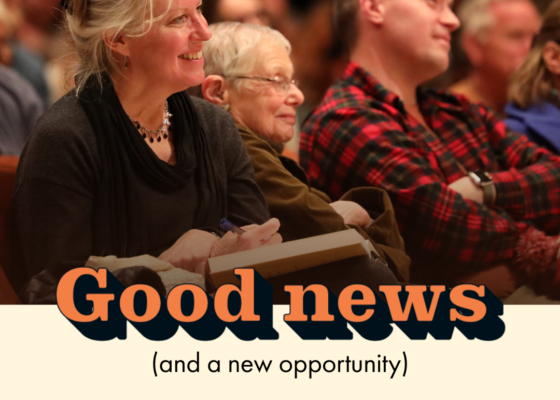5 things we learned from Timothy Egan
November 17, 2023On November 14 and 15, we were joined INconversation with Timothy Egan at Irvington Presbyterian Church, Kokomo Public Library and Ball State University. We’re grateful to Egan, author of A…
On November 14 and 15, we were joined INconversation with Timothy Egan at Irvington Presbyterian Church, Kokomo Public Library and Ball State University. We’re grateful to Egan, author of A Fever in the Heartland: The Ku Klux Klan’s Plot to Take Over America, and the Woman Who Stopped Them, and moderator Adam Wren, local journalist and creator of Importantville, for their thoughtful exchange about the finding of stories to tell, Indiana’s embrace of the book, teaching difficult histories and “what moves the heart from disagreement to hatred.”
As we like to do at Indiana Humanities, we’ve recapped the conversation below with 5 Things We Learned. Here are some moments that stood out to us:
1. Indiana’s embrace. As Egan wrote and completed A Fever in the Heartland, which looks at the difficult history of the Ku Klux Klan in Indiana, he was nervous about how our state might receive him and the book (or not). The interest Hoosier readers have shown in the book has been a pleasant surprise and joy to him as a writer. “I’ve gotten hundreds and hundreds of letters, notes, emails from Hoosiers just telling me they didn’t know this history and they’re happy to have it.” Even though the tale he tells in the book was among the darkest in Indiana’s history, Egan was encouraged. “I’m still an optimist. You believe the arc of history bends toward justice. You look for hope, you look for some light.”
2. Choosing which story to tell. As the author of ten books, Egan has developed a rubric for choosing which story he will tell next. His interests are broad, so he reminds himself to be open to serendipity. An initial idea for a book about the Klan in Oregon slowly shifted scenes to Indiana after Egan heeded signs and advice. Egan said that after he settles on the scene, next comes the search for a character, which is when he came upon the villainous D.C. Stephenson, who arrived in Indiana in 1921 and built the Klan’s power across the state over the next four years. And most important, Egan looks for a compelling story, which is why he decided to tell the story of Madge Oberholtzer.
3. Not-so-secret society. Stephenson famously said, “I did not sell the Klan in Indiana on hatred. I sold it on Americanism.” The Klan held parades, had a baseball team and even had a Klan Santa Claus during Christmas. In this context, Wren asked Egan about his statement characterizing Hoosiers as joiners. Egan spoke about the anti-Klan newspaper Tolerance, which thought it was going to damage the Klan when it released a “Who’s Who in Bedsheets” and listed of thousands of people in the community who were Klan members. The result was not what the paper expected: instead of shaming the members, it validated them and added to the sense of community. Your milkman, mechanic, neighbor, pastor . . . they all belonged! For Hoosiers, it wasn’t about the cachet of a secret society. It was about belonging, and the more the Klan operated in the open, the more membership climbed. “There was a sense that if you didn’t belong, you were missing something,” Egan said.
4. Heroic Hoosiers. The book shows the systematic way in which the Ku Klux Klan was working to seize power across the United States (and how close it came). It also tells the stories of the courageous Hoosiers who stood up to the hateful, violent group and contributed to its downfall. Among them were George Dale, the editor of the Muncie Post-Democrat who would go on to become mayor of Muncie; the rabbis who took a stand, including Rev. Dr. Joseph L. Fink, rabbi of Temple Israel in Terre Haute, who showed up alone to a Klan meeting in a cemetery and refused to be intimidated; and Marion County prosecutor Will Remy, who secured a guilty verdict against Stephenson at the murder trial in Noblesville. And, of course, there was Madge Oberholtzer, the young Irvington resident whose deathbed confession after a brutal assault by Stephenson began the collapse of the Indiana Klan. Egan said, “I couldn’t have written this story if there was no Madge, because I can’t write a history without some brightness, without some virtue.”
5. Teaching difficult histories. Conversation turned to if and how we should teach hard histories such as this. For Egan, it’s necessary. “You tell these stories, not just because they’re good stories, but because they’re alive today. They tell us something about ourselves.” He told the story about working with documentary filmmaker Ken Burns, who said to him, “History doesn’t repeat itself, but it rhymes.” Egan said that our task is to seek and find those rhyming moments in our history. Egan found himself in a tough position as a reader when he picked up Walter Isaacson’s Benjamin Franklin: An American Life. He read about the inventor, polymath . . . and slaveholder. “Does that mean we don’t study Franklin? No, it means we embrace nuance, we embrace complication. We embrace things that are seemingly at odds with each other,” Egan said. “And that’s the thing about Indiana’s history. There is a what-about-Indiana part of it, but there’s also great people who did great heroic, gutsy things.”
“Are we afraid of this?” Egan continued. “This is our subtext of our whole talk. Do we fear this or do we try to come to grips with it? . . . People will embrace a hard history if you just tell it fairly and don’t preach to them and show how it happened, because it expands your knowledge of humanity.”
You can view photos from the Indianapolis event here, view photos from the Muncie event here or watch a recording of the Indianapolis event here. (Password is MadgeOberholtzer).



